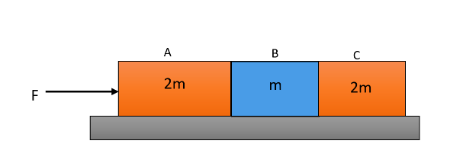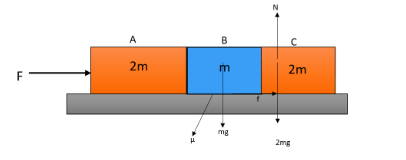
The system is pushed by a force $F$ as shown in the figure. All the surfaces are smooth except between B and C. Friction coefficient between B and C is $\mu $. Minimum value of $F$ in order to prevent block B from downward slipping will be given as,

\[\begin{align}
& A.\left( \dfrac{3}{2\mu } \right)mg \\
& B.\left( \dfrac{5}{2\mu } \right)mg \\
& C.\left( \dfrac{5}{2} \right)\mu mg \\
& D.\left( \dfrac{3}{2} \right)\mu mg \\
\end{align}\]

Answer
570.3k+ views
Hint: First of all the horizontal acceleration of the system is to be calculated. After that the normal force between B and C should be calculated. A body will not slide down if the frictional force acting over it is higher than the weight of the body. These all may help you to solve this question.
Complete answer:
First of all the horizontal acceleration of the system is to be calculated. This can be written as,
\[a=\dfrac{F}{2m+m+2m}\]
Where \[F\] is the force acting over the system and \[m\], \[2m\] are the masses of the body in the system.
Simplifying this equation will give,
\[a=\dfrac{F}{5m}\]
Now the normal force between the B and C blocks are given as,
\[N=\text{mass}\times \text{acceleration}\]
Here the mass is given as,
\[\text{mass}=2m\]
Acceleration is given as,
\[a=\dfrac{F}{5m}\]
Substituting the values in it will give,
\[\begin{align}
& N=2m\times a \\
& \Rightarrow N=2m\times \dfrac{F}{5m} \\
\end{align}\]
Therefore, the normal force can be simplified as,
\[N=\dfrac{2F}{5}\]
Now when we consider the block B, it will not move if the frictional force acting over it is greater than the weight of the block B. as we all know the weight of the block B will be written as,
\[w=mg\]
Where \[m\] be the mass of the block and \[g\] be the acceleration due to gravity.
The frictional force can be found by the equation,
\[f=\mu N\]
Where \[\mu \] be the coefficient of friction.
This relation can be shown mathematically as,
\[\mu N\ge mg\]
Substituting the value of normal force in it will give,
\[\mu \dfrac{2F}{5}\ge mg\]
Rearranging this equation will give,
\[F\ge \dfrac{5}{2\mu }mg\]
This will be the minimum value of \[F\] to prevent the sliding down of the block B.

So, the correct answer is “Option B”.
Note:
Frictional force is the force acting over a particle in order to prevent the motion of that particle when it is in contact with a surface. This force will be acting in the opposite direction of the force applied externally. This will be happening when the surface is not smooth. There is no ideal situation of the frictional force not happening in this universe.
Complete answer:
First of all the horizontal acceleration of the system is to be calculated. This can be written as,
\[a=\dfrac{F}{2m+m+2m}\]
Where \[F\] is the force acting over the system and \[m\], \[2m\] are the masses of the body in the system.
Simplifying this equation will give,
\[a=\dfrac{F}{5m}\]
Now the normal force between the B and C blocks are given as,
\[N=\text{mass}\times \text{acceleration}\]
Here the mass is given as,
\[\text{mass}=2m\]
Acceleration is given as,
\[a=\dfrac{F}{5m}\]
Substituting the values in it will give,
\[\begin{align}
& N=2m\times a \\
& \Rightarrow N=2m\times \dfrac{F}{5m} \\
\end{align}\]
Therefore, the normal force can be simplified as,
\[N=\dfrac{2F}{5}\]
Now when we consider the block B, it will not move if the frictional force acting over it is greater than the weight of the block B. as we all know the weight of the block B will be written as,
\[w=mg\]
Where \[m\] be the mass of the block and \[g\] be the acceleration due to gravity.
The frictional force can be found by the equation,
\[f=\mu N\]
Where \[\mu \] be the coefficient of friction.
This relation can be shown mathematically as,
\[\mu N\ge mg\]
Substituting the value of normal force in it will give,
\[\mu \dfrac{2F}{5}\ge mg\]
Rearranging this equation will give,
\[F\ge \dfrac{5}{2\mu }mg\]
This will be the minimum value of \[F\] to prevent the sliding down of the block B.

So, the correct answer is “Option B”.
Note:
Frictional force is the force acting over a particle in order to prevent the motion of that particle when it is in contact with a surface. This force will be acting in the opposite direction of the force applied externally. This will be happening when the surface is not smooth. There is no ideal situation of the frictional force not happening in this universe.
Recently Updated Pages
Why are manures considered better than fertilizers class 11 biology CBSE

Find the coordinates of the midpoint of the line segment class 11 maths CBSE

Distinguish between static friction limiting friction class 11 physics CBSE

The Chairman of the constituent Assembly was A Jawaharlal class 11 social science CBSE

The first National Commission on Labour NCL submitted class 11 social science CBSE

Number of all subshell of n + l 7 is A 4 B 5 C 6 D class 11 chemistry CBSE

Trending doubts
What is meant by exothermic and endothermic reactions class 11 chemistry CBSE

10 examples of friction in our daily life

One Metric ton is equal to kg A 10000 B 1000 C 100 class 11 physics CBSE

1 Quintal is equal to a 110 kg b 10 kg c 100kg d 1000 class 11 physics CBSE

Difference Between Prokaryotic Cells and Eukaryotic Cells

What are Quantum numbers Explain the quantum number class 11 chemistry CBSE




